高中英语语法总结之动词时态课件 牛津英语
文档属性
| 名称 | 高中英语语法总结之动词时态课件 牛津英语 | 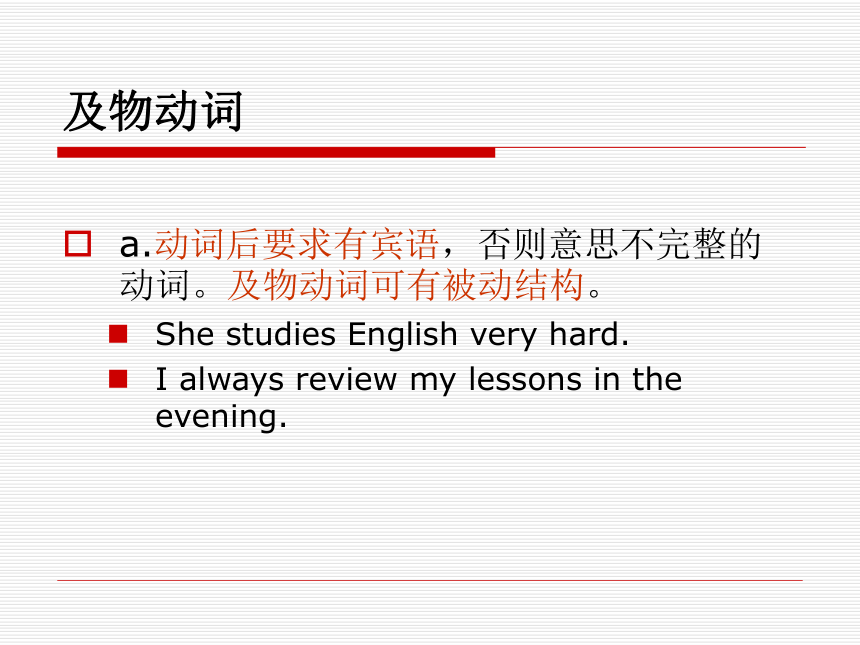 | |
| 格式 | zip | ||
| 文件大小 | 39.0KB | ||
| 资源类型 | 教案 | ||
| 版本资源 | 牛津译林版 | ||
| 科目 | 英语 | ||
| 更新时间 | 2013-12-16 22:01:17 | ||
图片预览


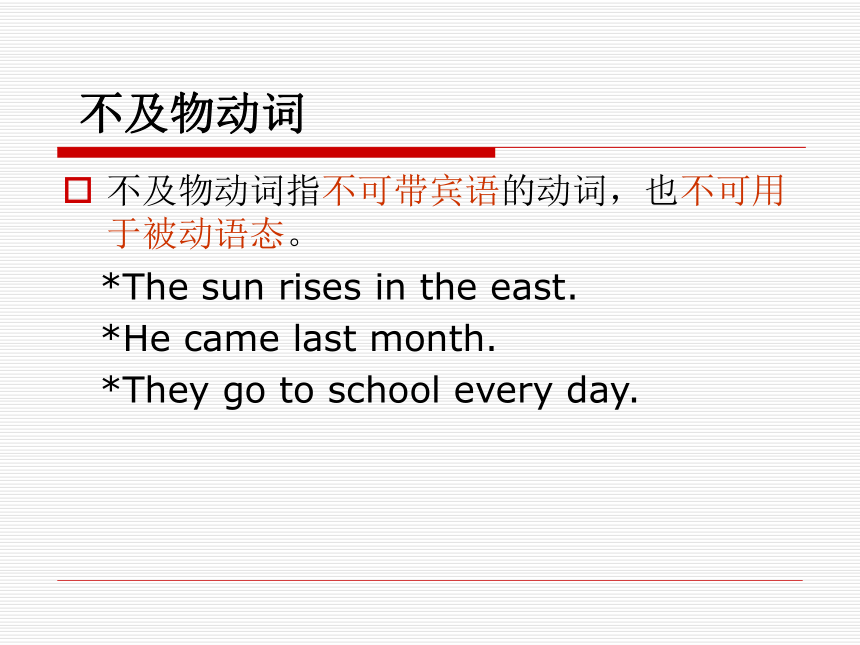
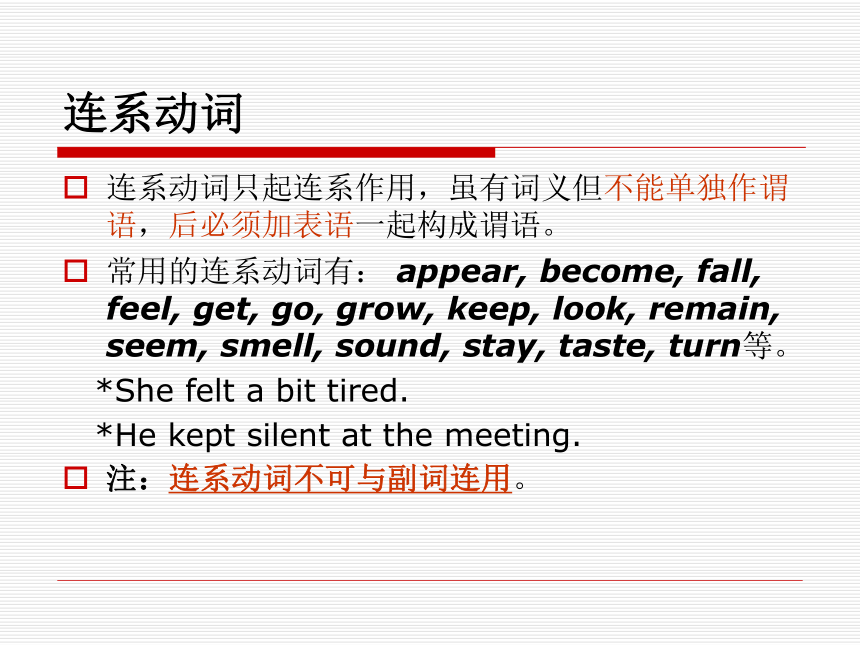
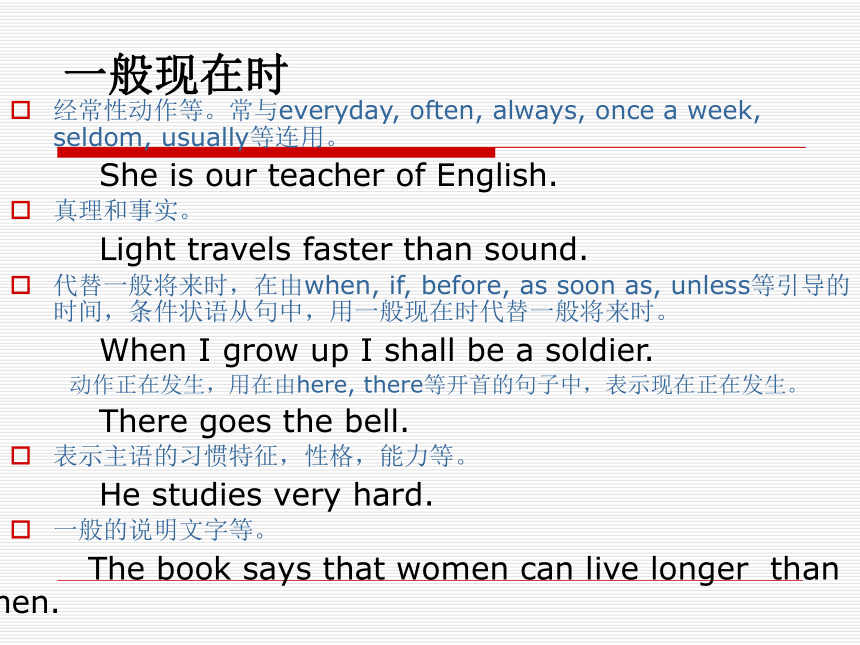
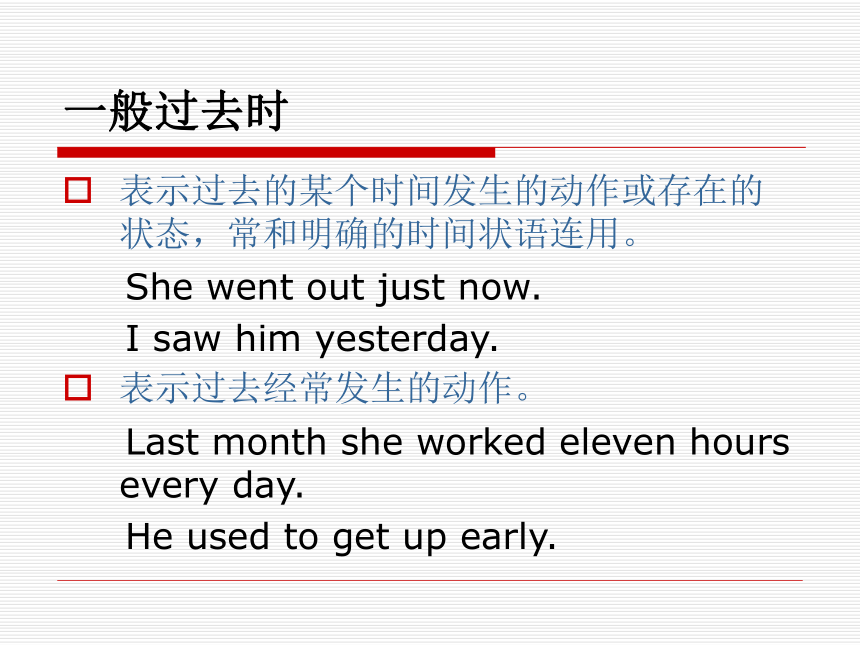
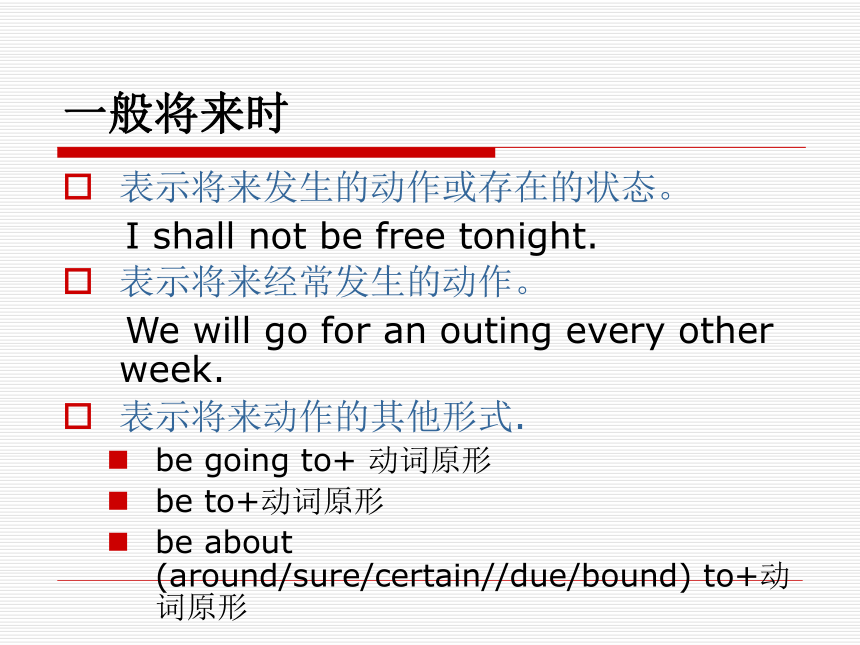
文档简介
课件17张PPT。及物动词
a.动词后要求有宾语,否则意思不完整的动词。及物动词可有被动结构。
She studies English very hard.
I always review my lessons in the evening.b. 及物动词的另两种结构
及物动词中有少数动词要求一个宾语(直接宾语)外,还要求有一个宾语(间接宾语),才使句意完整。这类动词有:leave, show, bring, lend, teach, give, tell, hand, write等。
*I’ll tell you a story about Lei Feng.
还有少数动词要求一个宾语外,还要求有一个补足语来使句意完整。这类动词有:name, call, get, have, find, turn, think, consider等。
They call him Lao Wang. 不及物动词不及物动词指不可带宾语的动词,也不可用于被动语态。
*The sun rises in the east.
*He came last month.
*They go to school every day.连系动词 连系动词只起连系作用,虽有词义但不能单独作谓语,后必须加表语一起构成谓语。
常用的连系动词有: appear, become, fall, feel, get, go, grow, keep, look, remain, seem, smell, sound, stay, taste, turn等。
*She felt a bit tired.
*He kept silent at the meeting.
注:连系动词不可与副词连用。一般现在时经常性动作等。常与everyday, often, always, once a week, seldom, usually等连用。
She is our teacher of English.
真理和事实。
Light travels faster than sound.
代替一般将来时,在由when, if, before, as soon as, unless等引导的时间,条件状语从句中,用一般现在时代替一般将来时。
When I grow up I shall be a soldier.
动作正在发生,用在由here, there等开首的句子中,表示现在正在发生。
There goes the bell.
表示主语的习惯特征,性格,能力等。
He studies very hard.
一般的说明文字等。
The book says that women can live longer than men.一般过去时表示过去的某个时间发生的动作或存在的状态,常和明确的时间状语连用。
She went out just now.
I saw him yesterday.
表示过去经常发生的动作。
Last month she worked eleven hours every day.
He used to get up early.一般将来时 表示将来发生的动作或存在的状态。
I shall not be free tonight.
表示将来经常发生的动作。
We will go for an outing every other week.
表示将来动作的其他形式.
be going to+ 动词原形
be to+动词原形
be about (around/sure/certain//due/bound) to+动词原形过去将来时表示在过去将来的某一时间发生的动作或存在的状态。
I didn’t expect that so many people would offer their help.
也可用was/were to+动词原形或was/were about to+动词原形或was/were going to+动词原形表示过去将来时。
I was about to leave when the telephone rang.现在进行时表示正在进行的动作。
What are you doing now?
表示即将发生的动作.
She is leaving tomorrow.
表示现阶段正在进行的动作.
More and more people are giving up smoking.
表示反复发生的或习惯性的动作,常表示不满,抱怨,赞赏等.
She is always finding fault with others.过去进行时 1. 过去某一时刻在进行的动作.经常需要表示过去的时间状语.
This time yesterday, they were having lunch.
2.过去进行时常与一般现在时配合,互为时间背景.
I was writing a letter when he came.
The telephone rang while she was washing.
3.过去反复的动作,常同always, frequently, continually等连用.
They were frequently going there.将来进行时 表示将来某一时刻正在进行的动作,常表示安排好的事.
They will be discussing the problem this time next week.
表示预料不久要发生或势必要发生的动作.
The train will not be leaving until one o’clock.现在完成时 表示动作刚刚完成.
I have finished that work.
表示过去做的动作对现在仍有影响.
Who has opened the door?
表示过去某时开始的动作一直延续到现在并且可能会延续下去.
He has worked in the company since he came to the city.过去完成时 表示在过去某一时间或动作之前已经完成的动作.
By the end of 2002,the factory had produces 200000cars.
表示在过去某一时间开始一直延续到另一个过去的时间的动作.
The old man had been ill for a long time before he died in 2002.当含有由before, after, as soon as等引导的复合句中,由于连词本身可以明确表示动作发生的顺序,故主句和从句一般都用一般过去时.
I went home after I finished my work.
过去完成时常用于no sooner than和hardly, scarcely…when等句型,从句用一般过去时.
He had hardly got on the train when the train started out.将来完成时 表示将来某一时刻或某一行为发生之前所完成的动作或这一动作仍在持续.常和by或by the time等连用.
By the end of this term, we shall have learned 18 lessons.现在完成进行时 表示从过去某时一直持续到现在的一个动作.
It has been snowing since last Sunday.
重复的动作表示感彩.
She’s been saying that twenty times.
已结束的动作所产生的影响.
You have been cleaning the classroom, I think.过去完成进行时表示过去某时以前一直进行的一个动作这一动作可能在这一时间前刚结束或仍在进行.
No one knew what this dad egg had been doing all this years.
a.动词后要求有宾语,否则意思不完整的动词。及物动词可有被动结构。
She studies English very hard.
I always review my lessons in the evening.b. 及物动词的另两种结构
及物动词中有少数动词要求一个宾语(直接宾语)外,还要求有一个宾语(间接宾语),才使句意完整。这类动词有:leave, show, bring, lend, teach, give, tell, hand, write等。
*I’ll tell you a story about Lei Feng.
还有少数动词要求一个宾语外,还要求有一个补足语来使句意完整。这类动词有:name, call, get, have, find, turn, think, consider等。
They call him Lao Wang. 不及物动词不及物动词指不可带宾语的动词,也不可用于被动语态。
*The sun rises in the east.
*He came last month.
*They go to school every day.连系动词 连系动词只起连系作用,虽有词义但不能单独作谓语,后必须加表语一起构成谓语。
常用的连系动词有: appear, become, fall, feel, get, go, grow, keep, look, remain, seem, smell, sound, stay, taste, turn等。
*She felt a bit tired.
*He kept silent at the meeting.
注:连系动词不可与副词连用。一般现在时经常性动作等。常与everyday, often, always, once a week, seldom, usually等连用。
She is our teacher of English.
真理和事实。
Light travels faster than sound.
代替一般将来时,在由when, if, before, as soon as, unless等引导的时间,条件状语从句中,用一般现在时代替一般将来时。
When I grow up I shall be a soldier.
动作正在发生,用在由here, there等开首的句子中,表示现在正在发生。
There goes the bell.
表示主语的习惯特征,性格,能力等。
He studies very hard.
一般的说明文字等。
The book says that women can live longer than men.一般过去时表示过去的某个时间发生的动作或存在的状态,常和明确的时间状语连用。
She went out just now.
I saw him yesterday.
表示过去经常发生的动作。
Last month she worked eleven hours every day.
He used to get up early.一般将来时 表示将来发生的动作或存在的状态。
I shall not be free tonight.
表示将来经常发生的动作。
We will go for an outing every other week.
表示将来动作的其他形式.
be going to+ 动词原形
be to+动词原形
be about (around/sure/certain//due/bound) to+动词原形过去将来时表示在过去将来的某一时间发生的动作或存在的状态。
I didn’t expect that so many people would offer their help.
也可用was/were to+动词原形或was/were about to+动词原形或was/were going to+动词原形表示过去将来时。
I was about to leave when the telephone rang.现在进行时表示正在进行的动作。
What are you doing now?
表示即将发生的动作.
She is leaving tomorrow.
表示现阶段正在进行的动作.
More and more people are giving up smoking.
表示反复发生的或习惯性的动作,常表示不满,抱怨,赞赏等.
She is always finding fault with others.过去进行时 1. 过去某一时刻在进行的动作.经常需要表示过去的时间状语.
This time yesterday, they were having lunch.
2.过去进行时常与一般现在时配合,互为时间背景.
I was writing a letter when he came.
The telephone rang while she was washing.
3.过去反复的动作,常同always, frequently, continually等连用.
They were frequently going there.将来进行时 表示将来某一时刻正在进行的动作,常表示安排好的事.
They will be discussing the problem this time next week.
表示预料不久要发生或势必要发生的动作.
The train will not be leaving until one o’clock.现在完成时 表示动作刚刚完成.
I have finished that work.
表示过去做的动作对现在仍有影响.
Who has opened the door?
表示过去某时开始的动作一直延续到现在并且可能会延续下去.
He has worked in the company since he came to the city.过去完成时 表示在过去某一时间或动作之前已经完成的动作.
By the end of 2002,the factory had produces 200000cars.
表示在过去某一时间开始一直延续到另一个过去的时间的动作.
The old man had been ill for a long time before he died in 2002.当含有由before, after, as soon as等引导的复合句中,由于连词本身可以明确表示动作发生的顺序,故主句和从句一般都用一般过去时.
I went home after I finished my work.
过去完成时常用于no sooner than和hardly, scarcely…when等句型,从句用一般过去时.
He had hardly got on the train when the train started out.将来完成时 表示将来某一时刻或某一行为发生之前所完成的动作或这一动作仍在持续.常和by或by the time等连用.
By the end of this term, we shall have learned 18 lessons.现在完成进行时 表示从过去某时一直持续到现在的一个动作.
It has been snowing since last Sunday.
重复的动作表示感彩.
She’s been saying that twenty times.
已结束的动作所产生的影响.
You have been cleaning the classroom, I think.过去完成进行时表示过去某时以前一直进行的一个动作这一动作可能在这一时间前刚结束或仍在进行.
No one knew what this dad egg had been doing all this years.
同课章节目录
- 名词
- 动词/动词短语
- 一般现在时及其被动式
- 一般过去时及其被动式
- 现在进行时及其被动式
- 过去进行时及其被动式
- 将来进行时及其被动式
- 现在完成时及其被动式
- 过去完成时及其被动式
- 一般将来时及其被动式
- 过去将来时及其被动式
- 现在完成进行时及其被动式
- 将来完成时及其被动式
- 副词
- 介词/介词短语
- 连词/连接词
- 数词/量词
- 冠词
- 形容词
- 非谓语动词
- 句型
- 简单句与并列句
- 复合句
- 主谓一致
- 倒装与省略
- 强调句
- 虚拟语气
- 插入语
- 固定句型
- 祈使句/感叹句
- 疑问句/反义疑问句
- 非限制性定语从句
- 句型转换
- 定语从句
- 表语从句
- 宾语从句
- 主语从句
- 动词时态与语态
- 虚拟语气与情态动词
- 主谓一致
- 独立主格结构、with的复合结构
- 情态动词
- 状语从句
- 定语从句
- 特殊句式
- 交际用语
- 代词/不定代词
- 名词性从句
- 同位语从句
- 表语从句
- 宾语从句
- 主语从句
- 直接引语和间接引语
- 构词法(word formation)
